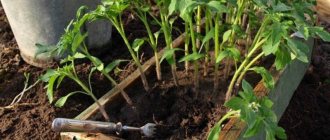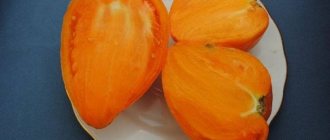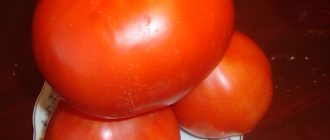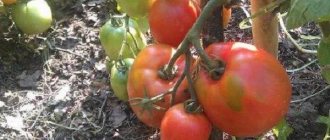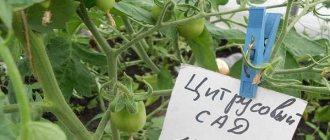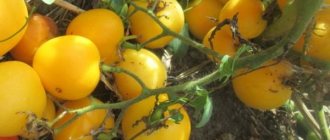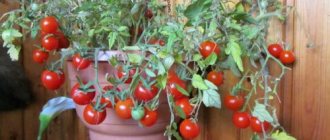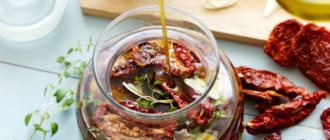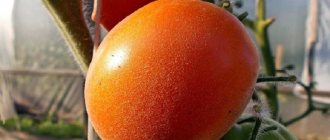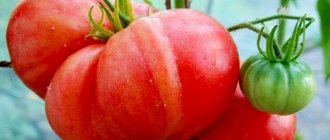Large-fruited tomatoes are very popular. Brutus is a giant, especially loved for its delicious tomatoes, which are good in slices and salads.
| Height | Landing location | Ripening time | Fruit color | Fruit size | Origin | Fruit shape |
| Tall | Greenhouse, Open ground | Mid-early | Reds | Large | Hybrid | Flat-round |
Description and characteristics of the variety
Brutus is a mid-early hybrid; tomatoes ripen 98-110 days after germination. It is an indeterminate and tall growing tomato. The shoots grow up to 2 m in height. Powerful bushes produce 7-8 heavy kilogram fruiting clusters. Garters require shoots and branches with tomatoes.
The variety is intended for open ground and covered greenhouses.
Tomatoes are large in size, average weight 600-700 g. The shape is round and flattened, slightly ribbed. At the break there is juicy fleshy pulp and many seed chambers. The taste is sweetish and harmoniously combines with light tomato sourness.
Diseases
Hybrid Brutus is characterized by resistance to diseases of nightshade crops, and this is confirmed by reviews from gardeners with photos of healthy bushes. However, it doesn't hurt to take preventative measures against diseases.
To do this, planting material should be disinfected by soaking them in a weak solution of manganese for 20 minutes. They should also water the soil prepared for seedlings. Before planting plants in the ground, you can pour one tablespoon of sifted wood ash into each hole.
This hybrid is especially loved by those gardeners who like to enjoy large sweet tomatoes during their growing season. And for harvesting, a large number of recipes with chopped tomatoes have long been invented, so the size of the fruit does not stop housewives planning to prepare delicious canned dishes for the winter.
Features of cultivation and storage
Seeds are sown throughout March. The soil is prepared to be fertile and loose. Mix turf with compost, ash, sand and peat. They are disinfected by pouring boiling water on them or calcining them in the oven.
The sowing depth of the seeds is 1.5 cm, the distance between the depressions is 2-3 cm. The seeds are pre-treated with Zircon, Guamat, Epin to accelerate germination.
Seedling care:
- Before germination, the boxes are covered with film and placed in a warm place at +22-24 °C;
- hardened for a week at 15°C;
- dive at the 2-leaf stage;
- illuminate with lamps up to a 12-hour daylight period;
- fed with complex nutrient solutions “Krepysh” and “Guamat Super”.
Description of tomato Brutus, reviews, photos
Indeterminate, mid-season, high-yielding tomato for greenhouses.
A bush 1.5-1.6 meters high , requiring tying to a support and pinching. The best results were obtained when forming a plant with 1 or 2 stems.
Fruit characteristics
photo author Natalya Ananyeva
The fruits are flat-round, large-ribbed, bright red in color at maturity, weighing 300-600 grams (up to 1 kg), juicy, with a classic tomato taste. These tomatoes are ideal for fresh consumption; they are also well suited for making juices and sauces.
To obtain the maximum size and weight of the fruit, form a bush with 1 stem and leave no more than 2 ovaries in the cluster.
During the period of fruit formation, it is advisable to fertilize, since the plant needs a lot of strength to produce such a number of large fruits.
This is a natural variety of tomato. Therefore, we recommend taking seeds from a ripe fruit and using them for planting in subsequent seasons.
Features of caring for plants in a greenhouse
In addition to watering, weeding and loosening, plants of the Brutus variety require garter throughout the entire main shoot. In this case, the supports must be of good quality, since a bush with a large number of heavy tomatoes is very heavy. The material for tying should be strong, but soft and wide so as not to injure the plant stems.
Another mandatory agrotechnical practice is pinching throughout the season. Otherwise, instead of a large fruit harvest, you may end up with impenetrable vines. The originator of the variety recommends growing bushes with one or two trunks. In order to form a tomato into one trunk, immediately after transplantation, begin to remove all shoots growing from the axils of the leaves. In the second method, in addition to the main stem, one stepson is left for further growth. As a rule, this is a stepson growing under the first cluster of flowers.
To prevent the formation procedure from damaging the tomatoes and causing infection, the following rules must be followed:
- stepchild only in the morning;
- If possible, choose dry and sunny weather;
- when removing a shoot, leave a stump 1-2 cm in size;
- after each bush, disinfect tools or gloves with potassium permanganate;
- The procedure should be carried out no more than once a week.
Important!
Tomatoes do not like stagnant air, so the greenhouse must be ventilated frequently. In summer, keep the greenhouse doors closed only when the air temperature is below 12°C or during prolonged cold rains.
Agricultural technology
Every experienced vegetable grower knows that in order to get a good harvest of tomatoes, it is important to observe the following key points: determine the correct sowing time, choose good seeds, good soil for seedlings and follow the rules of agricultural technology.
Sowing time
Seeds are sown based on the climatic conditions of their place of residence. In most regions this time falls in February-March. Seedlings are ready for transplanting into the ground after 60-65 days from germination.
Preparation of seed material
Of course, you can sow the seeds dry, without any pre-treatment. But many years of experience of vegetable growers shows that plants grown from seeds that have undergone preparation begin to bear fruit 1-2 weeks earlier, suffer less illness and produce a much larger harvest.
There are many methods for this, we list the main ones that should not be neglected:
Calibration In addition to the well-known method of immersing seeds in salt water for 20 minutes and discarding those that float, it is necessary to select seeds by appearance. From those that have already been treated with saline solution, select seeds of the same size, with smooth edges and without mold.
Etching. It is carried out to reduce the risk of fungal and viral diseases. The seeds are soaked in any antiseptic solution. You can buy it ready-made or prepare it yourself. The most common are pink potassium permanganate solution and light brown iodine solution. The seeds are soaked in them for a day.
Growth stimulation. Increases seed germination, strengthens resistance and improves the growth of future plants. Today there are a large number of ready-made biostimulants on sale. They are easy to prepare on your own. For example, soak the seeds in a solution of ash infused for 24 hours and strained (1 tablespoon per glass of water). A very popular and effective folk stimulant is aloe leaf juice diluted with water one to one. The seeds are soaked in such solutions for a day, during which time they will swell and be ready for planting.
You should know!
Dry seeds should not be soaked in potassium permanganate; if manganese gets into a dry seed, it is detrimental to the embryo. Therefore, they must be pre-soaked.
Preparing the soil for seedlings
You can prepare the soil for sowing yourself or buy a ready-made mixture. To prepare your own soil you will need:
- land from the forest or from an area where nothing grew for the next 2-3 years;
- peat;
- river sand.
All components are mixed in equal proportions.
The next step is to disinfect the resulting composition. The simplest and most effective way would be to pour boiling water over the soil first, and then a day later with a solution of raspberry-colored potassium permanganate. Such treatment will kill pathogenic microflora and will not affect beneficial microorganisms. Disinfected soil must be filled with fertilizers. To do this, add 2 scans of wood ash, 2 matchboxes of superphosphate, 1 tbsp to a bucket of soil. potassium sulfate and 1 tsp. urea.
Seedling care
Caring for tomato seedlings is to comply with the following conditions:
- maintaining temperature: 18-25°C during the day, 8-10°C at night;
- humidifying air that is too dry due to heating (with a humidifier or a damp towel on the radiator);
- illumination during short daylight hours and regular rotation towards the light source for uniform growth;
- watering as the soil dries;
- picking in the phase of 2-3 true leaves.
A week after the tomatoes have been planted, you can fertilize them with an infusion of ash; to do this, dissolve one tablespoon of wood ash in one liter of water.
Transplanting into a greenhouse
Seedlings ready for transplanting should be 25-30 cm high and have 9-10 true leaves. 2-3 days before planting, the lower leaves of the plants are torn off. Tomatoes are placed vertically in the holes, but they should not be deeply buried in the soil. Cloudy weather or evening hours are best for transfer events.
Plants of this variety require sufficient free space for normal growth and fruiting. Therefore, more than three bushes should not be planted per 1 m2. It is best to arrange the tomatoes in a checkerboard pattern in two rows.
Diseases and pests
Brutus is resistant to many diseases:
- mosaic;
- verticillium;
- gray rot;
- cracking.
To prevent phytospores in the early stages, they are treated with copper sulfate or Bordeaux mixture. Such remedies as “Ordan”, “Zaslon”, “Previkur” are effective against fungus.
Dangerous pests include whiteflies and tomato cutworms. To protect against caterpillars, bushes are sprayed with Actofit and Decis. During aphid infestations, Confidora is used.
Diseases and pests
The variety is immune to major tomato diseases and pests. Provided that the greenhouse and the soil in it were disinfected in the spring, the recommended planting scheme was followed, loosening and weeding are carried out regularly, no additional preventive work is required.
There is an opinion among summer residents that the larger the tomato, the more difficult it is to grow. The Brutus tomato variety completely refutes this. Despite the fact that the manufacturer recommends growing it in greenhouse conditions, according to reviews from gardeners, it grows well in open ground and does not require special care. The yield and taste are impressive.
Advantages and disadvantages of the variety
The main positive aspects of the Brutus tomato include:
- The fruits are simply gigantic in size;
- Low cost of seeds;
- Possibility of growing “on the balcony”;
- Ease of planting and caring for the plant;
- Resistance to pests and diseases.
The disadvantages include:
- A bountiful harvest requires more space;
- The first fruits ripen without seeds;
- The need for a garter.
